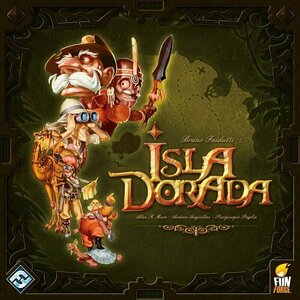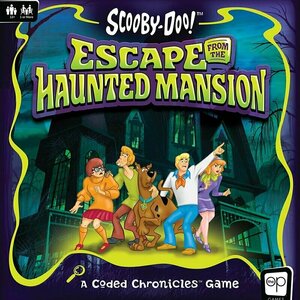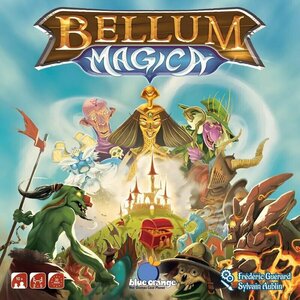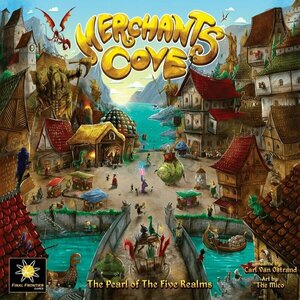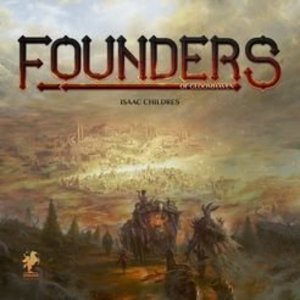Search
Search results
Purple Phoenix Games (2266 KP) rated Isla Dorada in Tabletop Games
Jun 24, 2021
I have always wanted to be an explorer. Not that I ever really would: I hate sweating, I need at least daily showers, I’m allergic to all the poison plants, and honestly, walking all that way in boots seems like such a drag. BUT! I will play games about exploring and totally get into the themes and mythos. I love them! How does a 10 year old game about exploring hold up to today’s gaming standards? Read on, weary traveler.
Isla Dorada is a set collection, hand management, bidding, exploration, adventure card and board game from a team of designers including Bruno Faidutti and Alan R. Moon. The players are a cohesive exploration team which has crash landed on an island, and they seek the riches within. To do this, the players will be traveling around the island attempting to satisfy their Destinies and pick up treasures along the way. But not every player wants to go where the others want to go. What to do, what to do…
Follow the setup instructions in the rule book until you have a board with turn tracker discs and the players’ shared totem pawn upon the crash site. Each differently-backed card deck will be shuffled and each player will receive cards drawn from these decks as their starting collection. The youngest player will receive the first player marker and will start the game by placing the totem on a path heading away from the crash site where they would like to go and announce the amount of cards they are willing to bid (even zero cards) in order to convince the party to travel there. The game is now on!
Players will be collecting Adventure cards to be used as currency when bidding on party travel in order to fulfill goals on their personal Destiny cards. When traveling each turn, a turn marker disc will be placed on the location the party has visited in order to track the movements for said Destiny cards, which mostly have lists of areas to be visited. They will also be attempting to avoid certain areas of the island which will trigger their Curse card that awards negative points at the end of the game. During two turns of the game players will be able to draw and choose cards from the Treasure deck that will help award points at game end as well. The winner is the player who best collects a combination of completed Destiny cards, Treasures, money, and considerations for negative points from Curses.
Components. People, Isla Dorada boasts some of the best components in a game we have seen. The totem pawn and Bigfoot/Leviathan pawns are simply amazing. The art throughout the game is mesmerizing and gorgeous. So much attention to little details have gone into this production and the final product is a stunning game that you want to keep playing because the component are just so fabulous.
But the game play? It is awesome with the right game mates. If you can play this with your enthusiastic friends, each turn will be simply exciting and joyous to play. Getting friends and family members to shout at each other their bids to move the party toward Septris instead of Methritis because their Curse card is brutal is downright great entertainment. Watching paths being cut off by the Bigfoot and Leviathan and having people visibly create alternate pathways and tactics can be enjoyable as well.
So do I like this game? Yep! It has beautiful components, is somewhat easy to teach to players of all experience levels, and leaves you satisfied when the game is over. This is not a serial, “play every game night” sort of title, but with the right group and mood, this can be a dynamite experience. If you are looking for a high-energy adventure game with lots of player interaction, set out to find a copy. I do wish you good luck, though, as a copy may be hard to come by. Alas, Purple Phoenix Games gives Isla Dorada a totemic 15 / 18. At least we will always have Kilitiping…
Isla Dorada is a set collection, hand management, bidding, exploration, adventure card and board game from a team of designers including Bruno Faidutti and Alan R. Moon. The players are a cohesive exploration team which has crash landed on an island, and they seek the riches within. To do this, the players will be traveling around the island attempting to satisfy their Destinies and pick up treasures along the way. But not every player wants to go where the others want to go. What to do, what to do…
Follow the setup instructions in the rule book until you have a board with turn tracker discs and the players’ shared totem pawn upon the crash site. Each differently-backed card deck will be shuffled and each player will receive cards drawn from these decks as their starting collection. The youngest player will receive the first player marker and will start the game by placing the totem on a path heading away from the crash site where they would like to go and announce the amount of cards they are willing to bid (even zero cards) in order to convince the party to travel there. The game is now on!
Players will be collecting Adventure cards to be used as currency when bidding on party travel in order to fulfill goals on their personal Destiny cards. When traveling each turn, a turn marker disc will be placed on the location the party has visited in order to track the movements for said Destiny cards, which mostly have lists of areas to be visited. They will also be attempting to avoid certain areas of the island which will trigger their Curse card that awards negative points at the end of the game. During two turns of the game players will be able to draw and choose cards from the Treasure deck that will help award points at game end as well. The winner is the player who best collects a combination of completed Destiny cards, Treasures, money, and considerations for negative points from Curses.
Components. People, Isla Dorada boasts some of the best components in a game we have seen. The totem pawn and Bigfoot/Leviathan pawns are simply amazing. The art throughout the game is mesmerizing and gorgeous. So much attention to little details have gone into this production and the final product is a stunning game that you want to keep playing because the component are just so fabulous.
But the game play? It is awesome with the right game mates. If you can play this with your enthusiastic friends, each turn will be simply exciting and joyous to play. Getting friends and family members to shout at each other their bids to move the party toward Septris instead of Methritis because their Curse card is brutal is downright great entertainment. Watching paths being cut off by the Bigfoot and Leviathan and having people visibly create alternate pathways and tactics can be enjoyable as well.
So do I like this game? Yep! It has beautiful components, is somewhat easy to teach to players of all experience levels, and leaves you satisfied when the game is over. This is not a serial, “play every game night” sort of title, but with the right group and mood, this can be a dynamite experience. If you are looking for a high-energy adventure game with lots of player interaction, set out to find a copy. I do wish you good luck, though, as a copy may be hard to come by. Alas, Purple Phoenix Games gives Isla Dorada a totemic 15 / 18. At least we will always have Kilitiping…

Bullseye - TV Gameshow and Darts
Games and Entertainment
App
*************************************************** * Bullseye - The Official Gameshow App * ...
Purple Phoenix Games (2266 KP) rated Hit the Silk! in Tabletop Games
Mar 9, 2021
Ok here’s the deal. You and your buddies have gone in deep with the casino and they are out to ice you if you don’t pay up. You have secured the funds to repay your debts and have hijacked the plane needed to get back to settle up. There’s just one problem: there are 3-6 of you and only 2-5 parachutes on board this plummeting aircraft. With whom to ally and can you make it off the plane with enough parachutes and money to make this run worth it?
Hit the Silk! is a semi-cooperative game about hidden information, strong and weak alliances, bluffing, and negotiation in the skies where the plane WILL go down. Players will be trading information with others in order to figure out which players they will unite with and which they will deceive to win the game. Not all players can win, and some players may not even survive the flight. WHO DO YOU TRUST?
DISCLAIMER: We were provided a prototype copy of this game for the purposes of this review. These are preview copy components, and I do not know for sure if the final components will be any different from these shown. Also, it is not my intention to detail every rule in the game, as there are just too many. For this preview I will be describing the Standard game mode. You are invited to download the rulebook, back the game through the Kickstarter campaign, or through any retailers stocking it after fulfillment. -T
To setup, place the Altimeter board on the table and set the needle to the correct altitude per number of players. The card organizer board is setup near the Altimeter with the Flannel cards on the Laundry space, the draw deck on the left space, and the discard pile between the two. Four cards are randomly placed face-down onto the Lockbox space on the Altimeter board, and six cards are dealt to the players. They will choose four to keep and discard the other two. Place all remaining components on the table. A first player is chosen and the game is setup to begin!
On a turn a player may do any or all of the following: Change a card, Take actions, Trade with another player. To change a card the current player will choose one card from their hand, either discarding face-up to the discard pile or to the Laundry if it is a Flannel card, and then drawing a number of cards pertaining to the altitude level on the Altimeter board (the higher the plane the less cards can be drawn). The player chooses one card to keep and discards the others.
Many cards will be action cards, so during a turn the active player can use as many action cards as they wish. To take an action the player simply notes any altitude adjustments printed on the card, adjusts the Altimeter needle by that much, then plays the card for its action. Some action cards allow players to Steal cards from another player (blocked by a Knife card), Spy another player’s hand, Handcuff two players together (or a player to a briefcase of money), use Key cards to unlock Handcuffs or to pilfer one card from the Lockbox on the Altimeter board, Poison another player (cured with the Antidote card), kick a weapon out of a player’s hand by using a Kung Fu card, or blatantly attacking a player by using both a Pistol and a Bullet card. Players will take one wound from the first bullet and will be permanently slain by taking another bullet wound.
The final action that can be taken on a turn is trading with another player. This is a risky action to take as players are not bound by their verbal agreements. Therefore, a player may offer to trade a Bullet and a Knife in exchange for a $10,000 and a Key card. However, neither player is REQUIRED to trade these exact items during the trade, and alliances weaken over trade disputes.
Intermittently throughout the game, as altitude drops, players are given the task to vote whether to keep flying or to hit the silk (which means to jump out of the plane with a parachute in hand)! Should players vote by majority to continue playing the game keeps going as before. If the players vote by majority to hit the silk!, then all players with parachutes reach the ground safely and pool together their money in hopes of reaching the goal amount determined at the start of the game. Those who jump without a parachute sadly perish, but those who are able to stay on the plane without being handcuffed to a jumping player may attempt the very difficult task of landing the plane (which involves the dice shown, but I will let you discover the method on your own).
Should the landing party have gathered enough money to pay the debt, those players win! If the player lands the plane correctly they win! If a player dies, well, they lose.
Components. Again, this is a prototype copy of the game, so components shown are probably going to look differently as the result of a successful Kickstarter campaign. That said, I want to first applaud Escape Plan Board Games for their usage of “eco-conscious production.” The component materials we received are certainly unlike any I have felt or played with in the past. They feel different, and I assume it is due to this new eco-friendly material they are using. I also want to point out the art style of Hit the Silk! It is fabulous and definitely gives off that jetset vibe. I love it! I do hope the dice will be getting an upgrade in the final version, as stickered dice are rarely in style. I have not seen or heard of any plans for upgrades or final components, but I hope a nice eco-friendly upgrade option exists for this game.
So here’s the rub. I truly like this game quite a bit. I do have issues with player elimination games, personally, because for whatever reason I am always the first to be targeted for elimination. While it’s funny at first, I despise having to be left out of the rest of the game. That said, I still very much enjoy this game. Yes, I don’t like being targeted, but I am able to take one for the team, and then ask players to try a different strategy the next playthrough. Being able to make loose alliances and just break trades by giving the other player two Flannels instead of the Parachute and Key is just fun times. I enjoy the ever-decreasing altitude of the plane that stresses players to get things done quickly without having the needle dip too far for comfort. I like that a lot.
I wish the dice were used more in the game (at least in Standard mode), as I love nice chunky dice, but I can look past this because the rest of the gameplay is so solid. I still have yet to figure out the best way to use the Handcuffs, but the weapons and Kung Fu are just so ridiculous and amazing simultaneously that I like using them as soon as I get them in hand. So if you, like me, have a hole in your collection for a game taking place in the skies featuring a gang of casino-chased hoodlums, then I urge you to take a look at Hit the Silk! Just know that if you handcuff yourself to me, you can bet on me making some very inappropriate comments.
Hit the Silk! is a semi-cooperative game about hidden information, strong and weak alliances, bluffing, and negotiation in the skies where the plane WILL go down. Players will be trading information with others in order to figure out which players they will unite with and which they will deceive to win the game. Not all players can win, and some players may not even survive the flight. WHO DO YOU TRUST?
DISCLAIMER: We were provided a prototype copy of this game for the purposes of this review. These are preview copy components, and I do not know for sure if the final components will be any different from these shown. Also, it is not my intention to detail every rule in the game, as there are just too many. For this preview I will be describing the Standard game mode. You are invited to download the rulebook, back the game through the Kickstarter campaign, or through any retailers stocking it after fulfillment. -T
To setup, place the Altimeter board on the table and set the needle to the correct altitude per number of players. The card organizer board is setup near the Altimeter with the Flannel cards on the Laundry space, the draw deck on the left space, and the discard pile between the two. Four cards are randomly placed face-down onto the Lockbox space on the Altimeter board, and six cards are dealt to the players. They will choose four to keep and discard the other two. Place all remaining components on the table. A first player is chosen and the game is setup to begin!
On a turn a player may do any or all of the following: Change a card, Take actions, Trade with another player. To change a card the current player will choose one card from their hand, either discarding face-up to the discard pile or to the Laundry if it is a Flannel card, and then drawing a number of cards pertaining to the altitude level on the Altimeter board (the higher the plane the less cards can be drawn). The player chooses one card to keep and discards the others.
Many cards will be action cards, so during a turn the active player can use as many action cards as they wish. To take an action the player simply notes any altitude adjustments printed on the card, adjusts the Altimeter needle by that much, then plays the card for its action. Some action cards allow players to Steal cards from another player (blocked by a Knife card), Spy another player’s hand, Handcuff two players together (or a player to a briefcase of money), use Key cards to unlock Handcuffs or to pilfer one card from the Lockbox on the Altimeter board, Poison another player (cured with the Antidote card), kick a weapon out of a player’s hand by using a Kung Fu card, or blatantly attacking a player by using both a Pistol and a Bullet card. Players will take one wound from the first bullet and will be permanently slain by taking another bullet wound.
The final action that can be taken on a turn is trading with another player. This is a risky action to take as players are not bound by their verbal agreements. Therefore, a player may offer to trade a Bullet and a Knife in exchange for a $10,000 and a Key card. However, neither player is REQUIRED to trade these exact items during the trade, and alliances weaken over trade disputes.
Intermittently throughout the game, as altitude drops, players are given the task to vote whether to keep flying or to hit the silk (which means to jump out of the plane with a parachute in hand)! Should players vote by majority to continue playing the game keeps going as before. If the players vote by majority to hit the silk!, then all players with parachutes reach the ground safely and pool together their money in hopes of reaching the goal amount determined at the start of the game. Those who jump without a parachute sadly perish, but those who are able to stay on the plane without being handcuffed to a jumping player may attempt the very difficult task of landing the plane (which involves the dice shown, but I will let you discover the method on your own).
Should the landing party have gathered enough money to pay the debt, those players win! If the player lands the plane correctly they win! If a player dies, well, they lose.
Components. Again, this is a prototype copy of the game, so components shown are probably going to look differently as the result of a successful Kickstarter campaign. That said, I want to first applaud Escape Plan Board Games for their usage of “eco-conscious production.” The component materials we received are certainly unlike any I have felt or played with in the past. They feel different, and I assume it is due to this new eco-friendly material they are using. I also want to point out the art style of Hit the Silk! It is fabulous and definitely gives off that jetset vibe. I love it! I do hope the dice will be getting an upgrade in the final version, as stickered dice are rarely in style. I have not seen or heard of any plans for upgrades or final components, but I hope a nice eco-friendly upgrade option exists for this game.
So here’s the rub. I truly like this game quite a bit. I do have issues with player elimination games, personally, because for whatever reason I am always the first to be targeted for elimination. While it’s funny at first, I despise having to be left out of the rest of the game. That said, I still very much enjoy this game. Yes, I don’t like being targeted, but I am able to take one for the team, and then ask players to try a different strategy the next playthrough. Being able to make loose alliances and just break trades by giving the other player two Flannels instead of the Parachute and Key is just fun times. I enjoy the ever-decreasing altitude of the plane that stresses players to get things done quickly without having the needle dip too far for comfort. I like that a lot.
I wish the dice were used more in the game (at least in Standard mode), as I love nice chunky dice, but I can look past this because the rest of the gameplay is so solid. I still have yet to figure out the best way to use the Handcuffs, but the weapons and Kung Fu are just so ridiculous and amazing simultaneously that I like using them as soon as I get them in hand. So if you, like me, have a hole in your collection for a game taking place in the skies featuring a gang of casino-chased hoodlums, then I urge you to take a look at Hit the Silk! Just know that if you handcuff yourself to me, you can bet on me making some very inappropriate comments.
Purple Phoenix Games (2266 KP) rated Scooby-Doo: Escape from the Haunted Mansion in Tabletop Games
Dec 1, 2020
YES! A Scooby-Doo game! AND it’s an escape room style game? I am so fired up to play this! This was my line of thinking as I received this game in the mail. Scooby-Doo is one of my favorite cartoon shows from my youth, and name a better episode than the Harlem Globetrotters episode. I’ll wait. So with a winning design team of Jay Cormier and Sen-Foong Lim (of the excellent Belfort game) this should be a giant hit, right?
Like I mentioned, Scooby-Doo: Escape from the Haunted Mansion is an escape room style board game with the tag of, “A Coded Chronicles Game.” This is a series of similar style games coming to us from the publisher using different IPs. This review will be lots different than our others because I do not wish to provide any spoilers, so I am eliminating my typical “messy components” shot at the end. I have also smudged the entire second photo so as not to give away anything. On to the review.
DISCLAIMER: We were provided a copy of this game for the purposes of this review. This is a retail copy of the game, so what you see in these photos is exactly what would be received in your box. I do not intend to cover every single rule included in the rulebook, but will describe the overall game flow and major rule set so that our readers may get a sense of how the game plays. For more in depth rules, you may purchase a copy online or from your FLGS. -T
To setup, read the rulebook, and turn to the proper paragraph number in the starting booklet. Each Mystery, Inc. character (“the gang”) has their own booklet with paragraphs and instructions inside. If you have ever played a game like Tales of the Arabian Nights you will know the style. The entry in the booklet will instruct players how to setup the first map tile and set the stage for the plot of the game.
This game features gameplay with no “turns,” so any person may choose to control a character from the gang and have them take some action. The possible actions that can be taken by the gang are: Velma may Research something, Shaggy can Eat stuff, Daphne Uses things, Scoob Smells, and Fred Investigates. Each character is assigned a single-digit number to be combined with items on the map tiles to arrive at a four-digit paragraph number. Find the number in the respective booklet and read aloud to the rest of the players. If successful, more map tiles may be added, or other things (being vague on purpose).
Should the entry not exist or instruct you to otherwise, players will need to “eat a Scooby Snack” by crossing off or reducing the total number of Snacks each time. We used another publisher’s pin to move along the track at the end of the rulebook because I didn’t feel like finding a coin.
As players progress through the game they will be presented with several challenges to figure out together. Half way through the game is a break time between Chapters 1 & 2. We were able to play this game over two nights utilizing the break.
At the end of Chapter 2 the game ends. If the players can successfully solve the case, they win! Alternately, if playing with academics, the rulebook provides a scale of VPs corresponding to the number of Scooby Snacks remaining. Whichever end-game method is chosen, the game is over and can be passed along to another household or gamer friend. That’s right, this is a one-shot escape room game. Only cheaters would go through it a second time…
Components. I cannot speak about many of the components, but I will evaluate what you see in the above photo. The rulebook and subsequent character booklets are all fine, but are curved as a result of how they sit in the box. The box itself is a strange design that you do not see with many board games. It’s not at all bad, just different. The cards are good, the map tiles are thin cardstock, and I can’t really discuss the Secret Envelopes. My biggest gripe about the game is the character standees. They are a long strip of thin stock that is folded in half, then the ends flared to make an inverted T shape. I mean, it’s fine, but this game could have done with a plastic stand for a sturdier standee to fit inside, or even basic miniatures. These standees that are included fall over all the time and when touched, even a little, flop on the table like a “professional” soccer player.
The gameplay, however, is very cool and I enjoyed my playthrough quite a bit. I very much enjoy one-shot games and despise when they ask you to destroy different components. No thanks, says me. Luckily, Scooby-Doo is able to be reset and given or sold to another person. I like that.
I also really enjoyed exploring the Haunted Mansion and trying to outwit the different challenges the game presented. This is not a particularly super difficult game to master, but will certainly give players a couple of fun hours of play with a group of animated childhood friends. For the nostalgia alone I would suggest this one, but there is also a pretty darn good game here. I have zero experience with the other Coded Chronicles Game from The Op (using The Shining), so I don’t know if I would enjoy it or not, but I loved Scooby-Doo and I adored my time with him. Purple Phoenix Games gives this one a meddling 12 / 18. If you are looking for a game you can circulate through your gamer friend network and enjoy the theme, then check out Scooby-Doo: Escape from the Haunted Mansion. It is cute, fun, and gives the ol’ noggin a workout. Also, privately message or email me and let me know if you figured out the correct ending. I did not.
Like I mentioned, Scooby-Doo: Escape from the Haunted Mansion is an escape room style board game with the tag of, “A Coded Chronicles Game.” This is a series of similar style games coming to us from the publisher using different IPs. This review will be lots different than our others because I do not wish to provide any spoilers, so I am eliminating my typical “messy components” shot at the end. I have also smudged the entire second photo so as not to give away anything. On to the review.
DISCLAIMER: We were provided a copy of this game for the purposes of this review. This is a retail copy of the game, so what you see in these photos is exactly what would be received in your box. I do not intend to cover every single rule included in the rulebook, but will describe the overall game flow and major rule set so that our readers may get a sense of how the game plays. For more in depth rules, you may purchase a copy online or from your FLGS. -T
To setup, read the rulebook, and turn to the proper paragraph number in the starting booklet. Each Mystery, Inc. character (“the gang”) has their own booklet with paragraphs and instructions inside. If you have ever played a game like Tales of the Arabian Nights you will know the style. The entry in the booklet will instruct players how to setup the first map tile and set the stage for the plot of the game.
This game features gameplay with no “turns,” so any person may choose to control a character from the gang and have them take some action. The possible actions that can be taken by the gang are: Velma may Research something, Shaggy can Eat stuff, Daphne Uses things, Scoob Smells, and Fred Investigates. Each character is assigned a single-digit number to be combined with items on the map tiles to arrive at a four-digit paragraph number. Find the number in the respective booklet and read aloud to the rest of the players. If successful, more map tiles may be added, or other things (being vague on purpose).
Should the entry not exist or instruct you to otherwise, players will need to “eat a Scooby Snack” by crossing off or reducing the total number of Snacks each time. We used another publisher’s pin to move along the track at the end of the rulebook because I didn’t feel like finding a coin.
As players progress through the game they will be presented with several challenges to figure out together. Half way through the game is a break time between Chapters 1 & 2. We were able to play this game over two nights utilizing the break.
At the end of Chapter 2 the game ends. If the players can successfully solve the case, they win! Alternately, if playing with academics, the rulebook provides a scale of VPs corresponding to the number of Scooby Snacks remaining. Whichever end-game method is chosen, the game is over and can be passed along to another household or gamer friend. That’s right, this is a one-shot escape room game. Only cheaters would go through it a second time…
Components. I cannot speak about many of the components, but I will evaluate what you see in the above photo. The rulebook and subsequent character booklets are all fine, but are curved as a result of how they sit in the box. The box itself is a strange design that you do not see with many board games. It’s not at all bad, just different. The cards are good, the map tiles are thin cardstock, and I can’t really discuss the Secret Envelopes. My biggest gripe about the game is the character standees. They are a long strip of thin stock that is folded in half, then the ends flared to make an inverted T shape. I mean, it’s fine, but this game could have done with a plastic stand for a sturdier standee to fit inside, or even basic miniatures. These standees that are included fall over all the time and when touched, even a little, flop on the table like a “professional” soccer player.
The gameplay, however, is very cool and I enjoyed my playthrough quite a bit. I very much enjoy one-shot games and despise when they ask you to destroy different components. No thanks, says me. Luckily, Scooby-Doo is able to be reset and given or sold to another person. I like that.
I also really enjoyed exploring the Haunted Mansion and trying to outwit the different challenges the game presented. This is not a particularly super difficult game to master, but will certainly give players a couple of fun hours of play with a group of animated childhood friends. For the nostalgia alone I would suggest this one, but there is also a pretty darn good game here. I have zero experience with the other Coded Chronicles Game from The Op (using The Shining), so I don’t know if I would enjoy it or not, but I loved Scooby-Doo and I adored my time with him. Purple Phoenix Games gives this one a meddling 12 / 18. If you are looking for a game you can circulate through your gamer friend network and enjoy the theme, then check out Scooby-Doo: Escape from the Haunted Mansion. It is cute, fun, and gives the ol’ noggin a workout. Also, privately message or email me and let me know if you figured out the correct ending. I did not.
Purple Phoenix Games (2266 KP) rated Bellum Magica in Tabletop Games
Jan 1, 2022
One of the many recent trends in board games has been that of playing as the villains in the game’s lore. One of the bigger games that I remember employing this little shift is Legendary: Marvel Villains, and another that I truly enjoy is Disney Villainous. There is just something about playing as the bad guys in a game that is designed for the bad guys to finally win. Enter Bellum Magica, a game that I didn’t even realize existed until it arrived on my door step from Blue Orange Games. I wonder, will this one find its way into my collection permanently?
Bellum Magica is a medieval fantasy engine building game for two to five players. In it, players are evil lords waging war on a local village and each other in an attempt to becoming the richest lord of all. The winner is the player who earns the most VP from treasure chests looted during the game.
DISCLAIMER: We were provided a copy of this game for the purposes of this review. This is a retail copy of the game, so what you see in these photos is exactly what would be received in your box. I do not intend to cover every single rule included in the rulebook, but will describe the overall game flow and major rule set so that our readers may get a sense of how the game plays. For more in depth rules, you may purchase a copy online or from your FLGS. -T
To setup, each player chooses a castle board and is randomly dealt two goblin cards to be added to the castle. These goblin cards have icons on the left and the right of the main character art, and will slide beneath the main castle board on either side to activate their icons for the duration. Next, the human kingdom (that will inevitably be attacked by players) is setup per number of players and placed on the table. The two different creature decks are shuffled and two cards from each pile are revealed. The other tokens are placed in the insert “token reserves” and are available to all. The first player takes the die and is known as the Captain. The game is now setup and ready to begin!
Each turn consists of six phases and, luckily, the game comes with a couple player aids to remind players of the order. First, the Captain rolls the die to Choose an active horde. Whichever result is rolled will then activate the corresponding line on the castle board, with all icons activating during the turn. If a player is unsatisfied with the rolled result, they may discard a barrel token in order to buy a round of drinks for the Captain, forcing them to re-roll the die. The Captain may also discard a Confusion Spell token in order to re-roll the die as well. These items are earned later in the game from different actions. Next, all players Gather resources (collect items) shown on the line that is activated on their castle board and any cards that have been added to alter these items (see photo below). Players will compare treasure map icons shown on the active line, and Call back their scouts who have gone in search of treasure chests. The player with the most icons will collect a metal chest, and if players are tied for the most, they each instead collect a wooden chest.
Once all items have been collected, players may enact the Attack action in turn order. Depending on the number and types of sword icons showing on the right side of players’ castle boards, they may choose to attack one of the face-up kingdom cards in the offer OR may choose to instead attack another player. In order to attack, the player will need to possess at least as many normal swords and/or magic swords as are showing on the kingdom card or on an opponent’s castle board. By successfully attacking, the player will collect spoils shown on the kingdom card, or may steal a treasure from an opponent, provided the attacker also possesses a thief icon on the active line.
When attacks are all resolved, players may next Recruit creatures from the setup creature decks by paying the recruitment costs (in food and glyph tokens). Players then decide under which side of their castle board they will slide the newly-acquired creature to aid in their efforts on future turns. These creatures can provide more resources or more attacking icons, depending on the side added.
After all these phases have been completed, the End of the Turn phase aptly finishes the turn. Cards are replenished and the new Captain is passed the die. Play continues in this fashion until one player has ten treasure chests at the end of an Attack phase. The player with the most VP from collected treasure chests is the winner!
Components. This game boasts some excellent artwork and some of the cutest little tokens I’ve seen. Firstly, the art is simply amazing. I love the looks of it, and the game is beautiful on the table once setup and playing. There are three types of wooden tokens that just make me smile while playing with them: little chicken legs, beer barrels, and cool little purple glyphs. I honestly wish they were bigger, but I understand cost of manufacturing places limitations when trying to keep products within a certain price point. All said, though, the components are great with this one!
I have one super tiny rule shrug: the addition of the Confuse Spell token and its rules. Now, I think I understand WHY it exists – these can be used every turn a player is Captain. So, it acts like a beer barrel, but is useful on future turns when you are Captain. If players are good at the game, and if you play with the full complement of players, you may not have many turns as Captain before someone wins, so I guess I don’t fully agree with the necessity of the Confusion Spells… except to further instill the fantasy theme.
That said, I still really enjoy Bellum Magica as a gateway-level engine builder. The more cards you add to your castle board, the better opportunities you give yourself to gain more and more resources throughout each turn. I have found that getting yourself a magic sword icon or more as soon as possible helps setup bigger turns and can be the difference between victory and embarrassment. As the kingdom cards start running out, their difficulty level increases, so having those extra magic swords come in handy big time. Also, investing in thief icons to be able to control other players’ treasure chest hoards may be invaluable. There are many ways to craft each turn to maximize effectiveness, and that helps keep Bellum Magica relevant and exciting to play.
It is probably no surprise by now, but I do enjoy playing Bellum Magica. When I first tried reading the rules I was a bit confused and wasn’t quite sure what the point was, but as I started playing more and more, the rules are really just pared down, almost like an outline or first draft. If you can stick with it and get it to the table, I believe you will find a very capable gateway engine building game with an accessible theme and great art and components. Purple Phoenix Games gives this one metal treasure chested 4 / 6. I do believe I will continue to love it more and more as I play it more and more. If you align with my board game tastes, this is an easy one to recommend. If you and I normally align somewhat, then I might suggest playing someone else’s copy before grabbing one of your own right away. I am more into gateway-weighted games than most reviewers, I’m sure, so this might be a bit lighter than your normal fare. In any case, I think this one needs to be played. A lot. If you ever see me out and about, or at a convention, let me know that you want to play this with me and I will not turn down the opportunity.
Bellum Magica is a medieval fantasy engine building game for two to five players. In it, players are evil lords waging war on a local village and each other in an attempt to becoming the richest lord of all. The winner is the player who earns the most VP from treasure chests looted during the game.
DISCLAIMER: We were provided a copy of this game for the purposes of this review. This is a retail copy of the game, so what you see in these photos is exactly what would be received in your box. I do not intend to cover every single rule included in the rulebook, but will describe the overall game flow and major rule set so that our readers may get a sense of how the game plays. For more in depth rules, you may purchase a copy online or from your FLGS. -T
To setup, each player chooses a castle board and is randomly dealt two goblin cards to be added to the castle. These goblin cards have icons on the left and the right of the main character art, and will slide beneath the main castle board on either side to activate their icons for the duration. Next, the human kingdom (that will inevitably be attacked by players) is setup per number of players and placed on the table. The two different creature decks are shuffled and two cards from each pile are revealed. The other tokens are placed in the insert “token reserves” and are available to all. The first player takes the die and is known as the Captain. The game is now setup and ready to begin!
Each turn consists of six phases and, luckily, the game comes with a couple player aids to remind players of the order. First, the Captain rolls the die to Choose an active horde. Whichever result is rolled will then activate the corresponding line on the castle board, with all icons activating during the turn. If a player is unsatisfied with the rolled result, they may discard a barrel token in order to buy a round of drinks for the Captain, forcing them to re-roll the die. The Captain may also discard a Confusion Spell token in order to re-roll the die as well. These items are earned later in the game from different actions. Next, all players Gather resources (collect items) shown on the line that is activated on their castle board and any cards that have been added to alter these items (see photo below). Players will compare treasure map icons shown on the active line, and Call back their scouts who have gone in search of treasure chests. The player with the most icons will collect a metal chest, and if players are tied for the most, they each instead collect a wooden chest.
Once all items have been collected, players may enact the Attack action in turn order. Depending on the number and types of sword icons showing on the right side of players’ castle boards, they may choose to attack one of the face-up kingdom cards in the offer OR may choose to instead attack another player. In order to attack, the player will need to possess at least as many normal swords and/or magic swords as are showing on the kingdom card or on an opponent’s castle board. By successfully attacking, the player will collect spoils shown on the kingdom card, or may steal a treasure from an opponent, provided the attacker also possesses a thief icon on the active line.
When attacks are all resolved, players may next Recruit creatures from the setup creature decks by paying the recruitment costs (in food and glyph tokens). Players then decide under which side of their castle board they will slide the newly-acquired creature to aid in their efforts on future turns. These creatures can provide more resources or more attacking icons, depending on the side added.
After all these phases have been completed, the End of the Turn phase aptly finishes the turn. Cards are replenished and the new Captain is passed the die. Play continues in this fashion until one player has ten treasure chests at the end of an Attack phase. The player with the most VP from collected treasure chests is the winner!
Components. This game boasts some excellent artwork and some of the cutest little tokens I’ve seen. Firstly, the art is simply amazing. I love the looks of it, and the game is beautiful on the table once setup and playing. There are three types of wooden tokens that just make me smile while playing with them: little chicken legs, beer barrels, and cool little purple glyphs. I honestly wish they were bigger, but I understand cost of manufacturing places limitations when trying to keep products within a certain price point. All said, though, the components are great with this one!
I have one super tiny rule shrug: the addition of the Confuse Spell token and its rules. Now, I think I understand WHY it exists – these can be used every turn a player is Captain. So, it acts like a beer barrel, but is useful on future turns when you are Captain. If players are good at the game, and if you play with the full complement of players, you may not have many turns as Captain before someone wins, so I guess I don’t fully agree with the necessity of the Confusion Spells… except to further instill the fantasy theme.
That said, I still really enjoy Bellum Magica as a gateway-level engine builder. The more cards you add to your castle board, the better opportunities you give yourself to gain more and more resources throughout each turn. I have found that getting yourself a magic sword icon or more as soon as possible helps setup bigger turns and can be the difference between victory and embarrassment. As the kingdom cards start running out, their difficulty level increases, so having those extra magic swords come in handy big time. Also, investing in thief icons to be able to control other players’ treasure chest hoards may be invaluable. There are many ways to craft each turn to maximize effectiveness, and that helps keep Bellum Magica relevant and exciting to play.
It is probably no surprise by now, but I do enjoy playing Bellum Magica. When I first tried reading the rules I was a bit confused and wasn’t quite sure what the point was, but as I started playing more and more, the rules are really just pared down, almost like an outline or first draft. If you can stick with it and get it to the table, I believe you will find a very capable gateway engine building game with an accessible theme and great art and components. Purple Phoenix Games gives this one metal treasure chested 4 / 6. I do believe I will continue to love it more and more as I play it more and more. If you align with my board game tastes, this is an easy one to recommend. If you and I normally align somewhat, then I might suggest playing someone else’s copy before grabbing one of your own right away. I am more into gateway-weighted games than most reviewers, I’m sure, so this might be a bit lighter than your normal fare. In any case, I think this one needs to be played. A lot. If you ever see me out and about, or at a convention, let me know that you want to play this with me and I will not turn down the opportunity.
Peter Shephard (2822 KP) rated Merchants Cove in Tabletop Games
Jun 4, 2021
Great range of character options (4 more)
Single player option
Great looking board and pieces
Expansions are great
Every character is like playing a different subgame
Great and Varied game
I backed this on Kickstarter, with the Oracle, Dragon Rancher and Inn Keeper expansions. Over the course of our first evening playing, my wife and I had 1 game of learning the rules, then another three games fairly quickly.
The pieces (ships, meeples, and individual gaming boards) are fantastic (although a couple are a little fiddly/weak) and every single character has their own flavour and type of sub-game;
The Alchemist makes potions by drawing marbles, firstly from a bag, then from a "decanter" (echoes of Quacks of Quiddlingberg)
The Blacksmith makes weapons and armour from dice rolls and combos in furnaces (not quite Yahtzee)
The Captain sails her fleet of ships to go fishing and treasure hunting using a spinning compass mechanism (can't put my finger what this reminds me of)
The Chronomancer (a great Back to the Future nod) travels through time portals to get pieces of technology, using a slide-and-shift board (like a mini Labrynth)
The Dragon rancher (believe it or not) hatches, raises and sells dragons; a couple of mechanics which work well together (even if one is shovelling poop) but not really like a game I've played
The Innkeeper is a great sub-sub-game; he can only sell drinks at one point, but he can put people up in his Inn which gives a bonus. A little bit of prediction work, but not like a other game I can think of.
The Oracle uses a scatter/dish for her fetishes and dice, and this limits what she can do - but I'd say she has the most varied scope of games (dots, predictions, and a few others)
The aim of the game is to be the Merchant who makes the most money, without attracting too much Corruption. Each game is played over three days, and each day has a limited amount of time. Each task the characters do has a different amount of time-cost - it might take 1h to brew potions, but it takes 2h to get ingredients from the decanter and prepare the potions. At several points each day, random Adventurers are drawn from the bag, and put into the travelling ships, as chosen by the drawer. However, there are also rogues who take up space and don't buy anything!
My only real complaint with the game is the comparatively long set up (5-10 minutes seems to be our average) for a 30-45m play time for 2 players - but it is really worth it. If/when this goes to retail, I'd say every gaming group who enjoys a combination of resource management, meeple and worker placement, and beautiful set-piece games, should give this a try.
The pieces (ships, meeples, and individual gaming boards) are fantastic (although a couple are a little fiddly/weak) and every single character has their own flavour and type of sub-game;
The Alchemist makes potions by drawing marbles, firstly from a bag, then from a "decanter" (echoes of Quacks of Quiddlingberg)
The Blacksmith makes weapons and armour from dice rolls and combos in furnaces (not quite Yahtzee)
The Captain sails her fleet of ships to go fishing and treasure hunting using a spinning compass mechanism (can't put my finger what this reminds me of)
The Chronomancer (a great Back to the Future nod) travels through time portals to get pieces of technology, using a slide-and-shift board (like a mini Labrynth)
The Dragon rancher (believe it or not) hatches, raises and sells dragons; a couple of mechanics which work well together (even if one is shovelling poop) but not really like a game I've played
The Innkeeper is a great sub-sub-game; he can only sell drinks at one point, but he can put people up in his Inn which gives a bonus. A little bit of prediction work, but not like a other game I can think of.
The Oracle uses a scatter/dish for her fetishes and dice, and this limits what she can do - but I'd say she has the most varied scope of games (dots, predictions, and a few others)
The aim of the game is to be the Merchant who makes the most money, without attracting too much Corruption. Each game is played over three days, and each day has a limited amount of time. Each task the characters do has a different amount of time-cost - it might take 1h to brew potions, but it takes 2h to get ingredients from the decanter and prepare the potions. At several points each day, random Adventurers are drawn from the bag, and put into the travelling ships, as chosen by the drawer. However, there are also rogues who take up space and don't buy anything!
My only real complaint with the game is the comparatively long set up (5-10 minutes seems to be our average) for a 30-45m play time for 2 players - but it is really worth it. If/when this goes to retail, I'd say every gaming group who enjoys a combination of resource management, meeple and worker placement, and beautiful set-piece games, should give this a try.

Twilight Struggle
Games
App
The #1 rated strategy board game gets its first expansion! Twilight Struggle: Turn Zero is a new...
BoardGames BoardgameApps Greatgames
Jason James (3 KP) rated Founders of Gloomhaven in Tabletop Games
Apr 4, 2019
Founders of Gloomhaven is a 1 to 4 player cooperative/competitive game. In short, players must work to build the city of Gloomhaven. The game provides a two-sided board and depending on which side you choose it slightly changes how the game is played. All players choose a character race and any additional resource cards. This determines which resources the players will automatically own during the game. However, other players will have the opportunity to buy access to resources they do not own. This is vital when building "upgraded" buildings. Each player starts with the same five cards (six cards in a two-player game). Players will have a chance to acquire new card by recruiting advisers, which are upgraded versions of the base cards. Play begins with a player laying down a card they wish to play. They follow the instructions on the top of the card, and then each other player will have a chance to follow the instructions laid out on the bottom of the card. Card actions can always be switched out with a set of basic actions (collect one gold or influence, build a road, or place a worker). If a player chooses (or is forced) to play a "Call to Vote" card, they collect one gold or influence, or build one road for each of the remaining cards in their hand. They reset all of their workers and collect their discard pile. All other players have a chance to collect gold based on the number of resources they own. Then all players vote for which prestige building they want to be built. All players reveal their choice token along with any influence they wish to spend. The player with the most votes gets to place the building anywhere on the map. Points are scored by connecting upgraded buildings to resources you own but is slightly more difficult with the games unique "trickle down" scoring system. This means that some points may have to be shared with players who own base the resources or other upgraded building needed to build the building that was just placed.
Overall this game is for people who enjoy other similar games like Catan or Ticket to Ride. Players must adjust to the fact that roads are public tiles that can connect any players resources to buildings. The game is high statistical and players must be able to make decisions that may result in other players gaining points. I would give the game an 8/10 as it brings a fresh feel to city-building board games! If you have any questions or have any comments on my review please feel free to message me.
Thanks!
Overall this game is for people who enjoy other similar games like Catan or Ticket to Ride. Players must adjust to the fact that roads are public tiles that can connect any players resources to buildings. The game is high statistical and players must be able to make decisions that may result in other players gaining points. I would give the game an 8/10 as it brings a fresh feel to city-building board games! If you have any questions or have any comments on my review please feel free to message me.
Thanks!
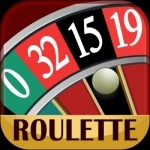
Roulette Royale - Grand Casino
Games and Entertainment
App
Virtually Experience Casino on Roulette Royale with the best designed wheel and friendly betting...
